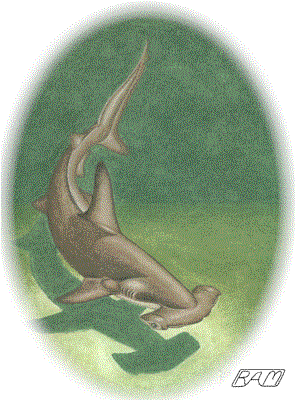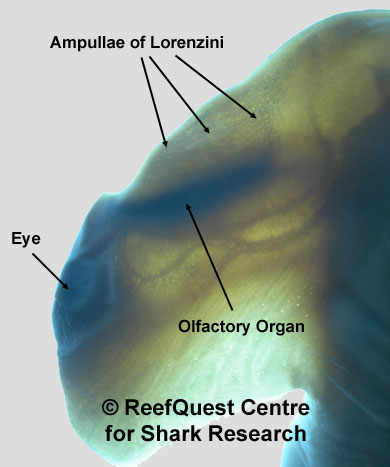If I Had a Hammer
Q: What is the purpose — if any — of the hammerhead shark's 'hammer'?
Drew
Bloomfield, NJ
A: The eight species of hammerhead are probably the most easily recognized of sharks. To a greater or lesser extent they all have elongated, flattened lobes projecting from the sides of their heads. These lobes contain specialized muscles and connective tissue and are supported by unique lateral expansions of the cartilaginous skull. Ever since people have been aware of hammerheads, they have been speculating — and debating — over just what function such bizarre headgear might serve. There are two basic schools of thought on the matter, boiling down to hydrodynamic advantages versus sensory enhancement.
 Those that favor a hydrodynamic function point to the hammers' overwhelming
similarity to an airfoil or canard. The hammer of all species is wing shaped in
cross-section (flattened on the lower surface and rounded on the upper) and may
therefore impart lift above the hammer. Hammerheads are known to be among the
most negatively buoyant of sharks. Although the size of the hammer varies from
species to species, the combined surface area of hammer plus pectoral fins
remains relatively constant. This suggests that some critical ratio of planing
surfaces to body size is being maintained. Recent work suggests that hammerheads
may have autonomic control over the trailing edge of their hammers, adding a
measure of maneuverability as well as lift. It seems that those supporting a
hydrodynamic function have a pretty strong case.
Those that favor a hydrodynamic function point to the hammers' overwhelming
similarity to an airfoil or canard. The hammer of all species is wing shaped in
cross-section (flattened on the lower surface and rounded on the upper) and may
therefore impart lift above the hammer. Hammerheads are known to be among the
most negatively buoyant of sharks. Although the size of the hammer varies from
species to species, the combined surface area of hammer plus pectoral fins
remains relatively constant. This suggests that some critical ratio of planing
surfaces to body size is being maintained. Recent work suggests that hammerheads
may have autonomic control over the trailing edge of their hammers, adding a
measure of maneuverability as well as lift. It seems that those supporting a
hydrodynamic function have a pretty strong case.
Sensory biologists and shark behaviorists are more impressed, however, by the potential for enhanced sensory acuity that may be afforded by the hammer. The nostrils of most hammerhead species are located near the outermost tips of the hammer and have specialized grooves which channel scent-bearing water to the nostrils. By having their nostrils mounted far apart, hammerheads may be able to sample a wider portion of the water column — sort of 'stereo sniffing'. The olfactory organ itself is elongated, perhaps taking advantage of the increased space available to it. Hammerheads are often the first sharks to arrive at an area where fish offal is being dumped overboard, suggesting that their sense of smell is particularly well developed.
All sharks have a series of pores peppered over their heads which look like a bad case of 5-O'Clock shadow. Called 'ampullae of Lorenzini', these pores are concentrated on the underside of a shark's snout, connecting to Coke bottle-shaped cells that are filled with an electrically conductive jelly. These ampullae are acutely sensitive to electromagnetic fields, including the weak bioelectric aura that surrounds every living creature. In hammerheads, the electrosensitive ampullae are distributed over the entire undersurface of the hammer, and may help these sharks locate prey. For example, a large species known as the Great Hammerhead (Sphyrna mokarran) has a definite taste for stingray flesh. Stingrays often lie partially buried on the bottom, making them difficult to detect. I have observed Great Hammerheads swimming close over the bottom, swinging their strange T-bar heads in broad arcs as though using the electroreceptive hammer like the sensor plate of a metal detector. On several occasions, I have seen 'mine-sweeping' Great Hammerheads double-back suddenly to scoop up one of several stingrays buried in the bottom silt. It is the minute electrical aura that keeps a stingray's heart and spiracles operating that betrays its presence to a hungry hammerhead (must be a scary thought if you happen to be a stingray!). Because the functional range of this mysterious sense is limited to a distance of about one foot by background 'static', stingrays would be very difficult to detect by sharks with 'normal-shaped' heads — except accidentally or by pure chance. By having the electrosensitive area expanded over the entire undersurface of the hammer, hammerheads may have a predatory advantage over other sharks.

Close-up of the left side of the
hammer of a Scalloped Hammerhead (Sphyrna lewini)
illuminated on a light table, showing the elongated olfactory (scent)
organ and pores of the ampullae of Lorenzini (electroreceptors).
Specimen in the collection of the LA County Museum of Natural History.
In the final analysis, the hammerhead 'hammer' is a complex structure that probably serves more than one purpose. Based on the foregoing and a knowledge of the biology of hammerhead sharks, I would rank the functions of the hammer (from most to least significant) as: 1) increasing electroreceptive acuity, 2) increasing scent-tracking efficiency, 3) increasing maneuverability, and 4) increasing lift. Only time and further research will tell for sure.
Originally published in Rodale's Scuba Diving, August 1993
